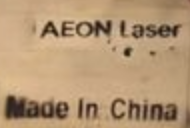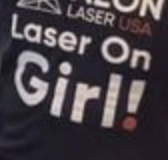Is there a reason no one is talking about this?
I’d buy this in a heartbeat. If I could sell my Glowforge Pro for 5.5k right now.
Is there a reason no one is talking about this?
I’d buy this in a heartbeat. If I could sell my Glowforge Pro for 5.5k right now.
I guess because this is a forum for sharing ideas, projects and help for the Glowforge.
maybe because of the price? I had never heard of it before now.
the Aeon Desktop (mira 5) looks much more comparable in terms of specs.
I like the metal case, integrated cooling,
Don’t like the idea of having to do mirror alignment with a red dot.
No one ever talks about the Kern lasers either, but they awesome.
lol, Yea for what all it offers.
For me it’s a no brainer.
buy one, tell us how it works.
Will do once I have the money!
There is more than one way to read that ![]()
There are many Lasers at many price points designed for different projects and not one is good for everything. many have a deep floor designed to engrave thick gifts so if that is your need then that should be your machine,
The one you priced out would be even larger than the one pictured here.
Not exactly a desktop unit for the home.
For me, the no-brainer is spray-painted right on the crate:

YVMV.
Surely, everything in the Glowforge (Parts) weren’t manufactured in the United States. It may have been assembled here, but the part manufactured in China.
A motorcycle company used to do the same thing. Lots of the parts were imported and assembled in the US. Technically they were allowed and no one had any issues especially with a “Made in USA” sticker on it. So the “Made in China” doesn’t bother me.
I’d go with a real laser company - a Trotec or Epilog for that kind of money. Even used, one of those is a solid purchase. Once you hit the 10K mark, it’s not hard to find a good machine from a company with a history and track record vs. the latest Alibaba special.
Made in the USA from internationally sourced components. This is pretty much everything that has a microchip.
Some people do have issues with this, but that’s an entirely different discussion.
It does bother me, but like I said, Your Views May Vary and that’s fine.
also this guy’s shirt desperately needs a comma!

Warning, Proofgrade material not detected.
I was at 10k for the first Universal unit - 60 watt, metal tube, significantly faster.
Just for specs comparison…
The Mira does about 45 inches per second. The Universal does 75 inches per second. The Trotec does 140 to 170 inches per second depending on the model. The Glowforge is around 5.5” per sec at 1000 speed. I think 4000 speed is in the ballpark of 22-25 inches per second? I’d have to calculate it on my old spreadsheet.
What the specs don’t tell you is that very often you won’t be using the 45 inches per second on the Mira. Having 90 watts helps with marking at higher speeds for sure, but you also have the reality of how fast you can actually engrave with a glass tube. How fast it can fire accurately. This really comes into play on detailed graphics and dithered images. Where many other glass tube lasers hold an advantage over the Glowforge is in the head turn around time. That overshoot adds up quite a bit.
Or, I dunno, the FTC, which has specific regulations for claiming Made in the USA.
There’s a big advantage to a machine with one of those over glass tube machines that doesn’t get mentioned much. Power delivery seems to be “hotter” to me (so you can run faster), they last longer and can be recharged. It’s not uncommon to get 10K hours on a good metal tube. I haven’t really seen that discussed much here when alternative laser topics come up.
Plenty of people are talking about it, which you may already know if you’re doing any research. Heck, I’ve even talked about it. Talking about it HERE seems in poor taste, though. GF is a pretty good sport about things like this, but I don’t think I’d appreciate if people came onto my page to chat up my competition.
They’re really not competitors. The good 10K+ machines are much faster and generally more powerful than a GF. They’re really much better suited for commercial use.
The other 5K and below machines aren’t really up to snuff yet although the Dremel/Muse and a couple of other somewhat bespoke Chinese lasers are more in line with the GF. But none of them come with the ease of use and ecosystem the GF has. (And really, despite the complaints, it’s pretty easy to use.)
The really low end CCL are for a different market as well - the inveterate tinkerers who look at remaking the machine as much a part of what they want as actually making anything with it.
What’s surprising is how long GF has gone without any real competition in its core market.
Right?
I’m pretty surprised nobody has beat them on cost/hardware at the same quality. There are enough things to improve on with the GF design that it shouldn’t be hard to outdo it.
This is true. In order to have a Made in USA sticker, it has to be fully assembled here and consist of mostly US made parts…I believe (the FTC has requirements that need to me met). The regulation could’ve changed, but when I was in college, the only ones with different regulations were automobiles, textiles, and furs. Otherwise the product will have different labels, like “Assembled in USA,” or “Made in USA with Imported Parts.”
But keep in mind I majored in international trade over a decade ago and trade law changes all the time. But the FTC does have requirements that need to be met to get the Made in USA label.
What I can also tell you is that after you get everything hooked up… your big fan, your water chiller, etc. you are more than likely going to spend several hours, or more, doing a full beam alignment which will be tedious tweaking of mirror to mirror to make sure the beam is centered properly, and then you’ll go to the next corner to make sure that it’s still aligned across the table, and it probably won’t be, so then you’ll be going back and forth making smaller and smaller adjustments to find the common spot where the alignment doesn’t deviate.
And then some people never get it aligned correctly. And if you’re running one of these large bed lasers without a collimator/beam expander/telescope, you’re going to have constant complaints about large jobs that spread across the entirety of the bed because the beam quality will change across such a large area.
And then you might forget to drain your water trap, or change out your desiccant, and have water spewing through the air assist across your project. Oh, forgot to mention the air compressor you’ll likely want to hook up. Could be a constant on vacuum pump style, which gets a bit annoying, or a large 30-gallon compressor that’s going to need it’s own circuit, and possibly a 220. With 90 watts of power, your bigger exhaust fan, the chiller, the air compressor, you’re likely going to need at least 2 dedicated circuits in the room.
I don’t know 100% sure where I fall in the whole scheme of where everything is made, so I just use Made in Texas ![]() Texas does have a Go Texan program which is kind of like the Made in the USA claim, which I do believe I qualify for, so I’ve considered getting into that program.
Texas does have a Go Texan program which is kind of like the Made in the USA claim, which I do believe I qualify for, so I’ve considered getting into that program.
I’m pretty sure you’re fine. It applied to big business. I only know it because I worked in the fashion industry, and there was a huge focus on where things are made and assembled in terms of parts because each country had trade limitations. At the time, China was only allowed it export to the US a certain number of clothing a year, and if most of the parts were made in China, but assembled in like Vietnam, it made a difference…I think…it’s been a while since I’ve had to use that part of my memory. ![]()